Related Research Articles
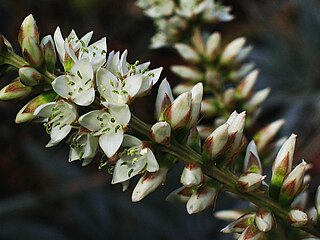
Hechtia is a genus of plants in the family Bromeliaceae, and is the sole genus of the subfamily Hechtioideae, containing 75 species. Its species are native to Mexico, Central America, and Texas.

Trixis is a genus of shrubs in the aster family, Asteraceae, native to North and South America including the West Indies.
Pereilema is a genus of Latin American plants in the grass family.

Hofmeisteria is a genus of Mexican flowering plants in the sunflower family.

Hilaria is a genus of North American plants in the grass family. Members of the genus are commonly known as curly mesquite. They are found in the Southwestern United States, Mexico, and Guatemala.

Tridax is a genus of flowering plants in the daisy family.

Hymenostephium is a genus of flowering plants in the family Asteraceae. It includes herbs and slender shrubs that occur from Mexico through Central America and into South America.
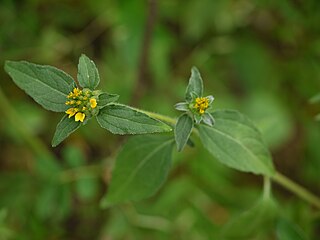
Sclerocarpus is a genus of flowering plants in the sunflower tribe within the daisy family. Bonebract is a common name for plants in this genus.
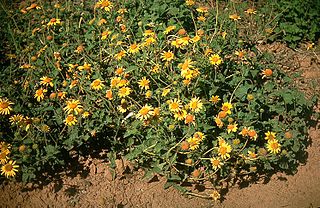
Simsia is a genus of flowering plants in the sunflower tribe within the daisy family. It includes annuals, herbaceous perennials, and shrubs. They range from the western United States south through Central and South America to Argentina, with the center of diversity occurring in Mexico. The genus is named for British physician and botanist John Sims (1749–1831). Although some species are relatively rare, others have become common weeds that line the roadsides and fields of Mexico, often forming dense stands mixed with Tithonia and other Asteraceae. Some species are known by the common name bushsunflower.
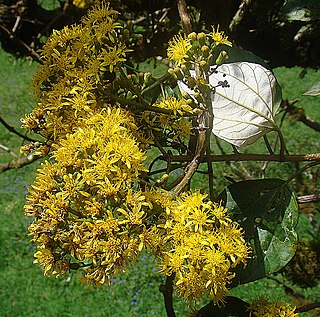
Sinclairia is a genus of Latin American plants in the Liabeae tribe within the daisy family.

Montanoa is a genus of flowering plants in the sunflower tribe within the daisy family.
Otopappus is a genus of flowering plants in the sunflower tribe within the daisy family, primarily Mesoamerican but with one species from Jamaica.
Stachycephalum is a genus of plants in the family Asteraceae.

Perymenium is a genus of South American and Mesoamerican plants in the sunflower tribe within the daisy family.
Axiniphyllum is a genus of flowering plants in the daisy family.
Aulosepalum is a genus of flowering plants from the orchid family, Orchidaceae. It consists of 8 species native to Mexico and Central America.
- Aulosepalum hemichrea(Lindl.) Garay - Oaxaca, Chiapas, El Salvador, Guatemala, Honduras, Nicaragua
- Aulosepalum nelsonii(Greenm.) Garay - Michoacán, Oaxaca
- Aulosepalum oestlundii(Burns-Bal.) Catling - Guerrero
- Aulosepalum pulchrum(Schltr.) Catling - Guatemala and southern Mexico
- Aulosepalum pyramidale(Lindl.) M.A.Dix & M.W.Dix - from central Mexico to Costa Rica
- Aulosepalum ramentaceum(Lindl.) Garay - Tamaulipas, San Luis Potosí
- Aulosepalum riodelayense(Burns-Bal.) Salazar - Oaxaca
- Aulosepalum tenuiflorum(Greenm.) Garay - Morelos, Guerrero
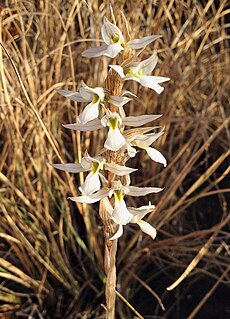
Deiregyne is a genus of flowering plants from the orchid family, Orchidaceae, native to Mexico, Guatemala and Honduras.
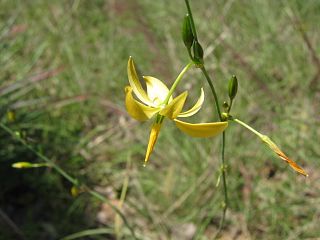
Echeandia is a genus of New World plants in the century plant subfamily within the asparagus family. It is named for Spanish botanist Pedro Gregorio Echeandía (1746–1817). Species in the genus are distributed from the south-western United States south to north-western Argentina, southern Bolivia, and southern Peru. They are herbaceous perennials with corms and enlarged storage roots. The narrow leaves are held in basal rosettes. Flowers are in loose racemes and may be yellow, orange, white or cream.

Cunila is a genus of plants in the Lamiaceae, first described in 1759. It is native to North and South America.
- Cunila angustifoliaBenth. - southern Brazil, Misiones Province of Argentina
- Cunila crenataGarcía-Peña & Tenorio - State of Durango in Mexico
- Cunila fasciculataBenth. - southern Brazil
- Cunila galioidesBenth. - Brazil
- Cunila incanaBenth. - southern Brazil, Argentina
- Cunila incisaBenth. - southern Brazil
- Cunila leucanthaKunth ex Schltdl. & Cham. - Mexico, Central America
- Cunila lythrifoliaBenth. - central + southern Mexico
- Cunila menthiformisEpling - southern Brazil
- Cunila menthoidesBenth. - Uruguay
- Cunila microcephalaBenth. - southern Brazil, Argentina, Uruguay
- Cunila origanoides(L.) Britton - central + eastern United States from Texas and Kansas east to New York and Georgia
- Cunila platyphyllaEpling - southern Brazil
- Cunila polyanthaBenth. - Mexico, Central America
- Cunila pycnanthaB.L.Rob. & Greenm. - Mexico
- Cunila ramamoorthianaM.R.Garcia-Pena - Mexico (Guerrero)
- Cunila spicataBenth. - southern Brazil, Argentina, Uruguay, Paraguay
- Cunila tenuifoliaEpling - southern Brazil
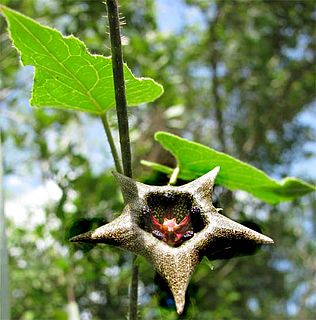
Dictyanthus is a genus of plant in family Apocynaceae, first described as a genus in 1844. It is native to Mexico and Central America
References
- ↑ Bentham, George. 1872. Hooker's Icones Plantarum 12: pages 14–15 descriptions in Latin, habitat information and figure captions in English
- ↑ Bentham, George. 1872. Hooker's Icones Plantarum 12: plante 1116 line drawing of Desmanthodium perfoliatum
- ↑ Tropicos, Desmanthodium Benth.